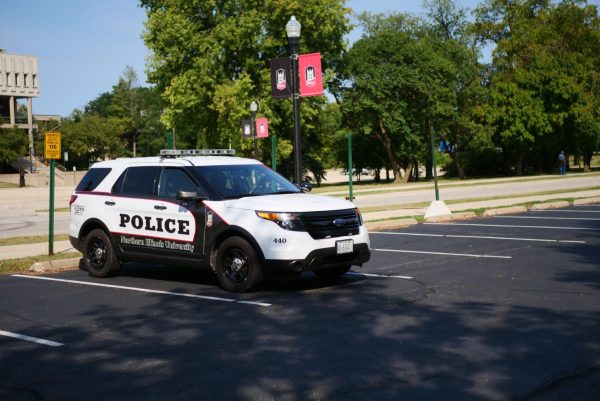Weekend Winterland
January 23, 2006
Sophomore special education major Jill Benbennick planned to go to Chicago with friends this weekend, but like many others, had to postpone her plans due to the snow.
“The roads need to be cleared for people to go to work, or shopping, or even to see the Harlem Globetrotters,” Benbennick said.
Benbennick and others who park their cars on campus have places to go, and some students this weekend chose to use their snow brush as a trowel instead of waiting for the roads to melt.
On Sunday afternoon, however, the pavement again was visible, a result of the weekend efforts of the NIU Grounds crew.
Assembling a strike team
When the snow begins to pile up, the cleanup effort can be massive; the campus stretches from Barsema Hall to the Convocation Center, considered by some to be a long walk.
The process begins when the University Police determine the roads are getting bad and call Darryl Grayson, interim superintendent of Grounds, who in turn notifies his department. If the snow gets worse, Grayson calls the entire department of 20, and everyone works until everyone finishes.
“I started here in ’84,” Grayson said. “We had, I think, 34 guys in our department. Today we have 20, and we got a lot more sidewalk and parking lots to take care of.”
The streets are attacked with one main street plow, and Grounds also has four 1-ton dump trucks, two of which have salt spreaders. Additionally, there are two pickups for the walkways and four smaller lawnmowers fitted with 52-inch snow blades for smaller sidewalks. The campus usually becomes drivable after about two hours of work, Grayson said.
Overcoming delays
Modern equipment has come a long way since the invention of the shovel, but obstacles still exist.
Some of the older roads have unusual features, causing manholes to jut up from the ground into the path of the plow blade.
“That’ll rattle the hell out of your teeth,” Grayson said.
Parking lots also are subject to schedule conflicts, as impatient students and professors often park in a lot where a plow is pushing snow. Usually this leaves a patch behind; the extra minutes spent plowing around the car are precious and the plow drivers are not going to come back just to see if the car has left.
The Aftermath
After the initial plowing is complete, the work is not quite finished; the snow needs to be hauled away.
There are two designated areas, one to the north of residence hall parking, and one east of Anderson Hall, where all of the cleared snow eventually is deposited.
Grayson said one year they had just finished when the snow began again.
“We worked something like 36 hours straight that snow,” Grayson said. “We’ll come back, and guys will take a nap back in the shop or something, so they’re not out there driving the truck really fatigued.”
A budget cushion allows for the unplanned overtime, but the job actually is not complete until spring because sidewalks and roads are difficult to see through the snow. There also is a possibility of tearing the topsoil.
“We try not to scout the ground,” Grayson said. “But sometimes you just can’t help it.”
Grayson said the root system usually is still present and that after proper care with a silage fork, the grass normally grows back full and green.
Behind the scenes
With varying figures of material costs and overtime, an annual budget for plowing is difficult to pinpoint. The plowing budget is based on a historical average, looking at the cost of materials, equipment and labor from the previous five years, said Michael Saari, associate director at the physical plant.
“We add an average of 5 to 6 percent for unseen events,” Saari said.
He also said anything left over returns into a central account, reallocated in the next fiscal year. The budget annually provides for truck fuel, labor and an average 340 tons of special road salt called Snow Slicer.
Snow Slicer, which is about 95 percent sodium chloride (table salt), also contains a special corn-based carbohydrate called Caliber M2000, and as a result sticks to the roads better and works at a colder temperature than normal road salt.













